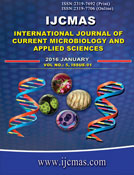


 National Academy of Agricultural Sciences (NAAS)
National Academy of Agricultural Sciences (NAAS)

|
PRINT ISSN : 2319-7692
Online ISSN : 2319-7706 Issues : 12 per year Publisher : Excellent Publishers Email : editorijcmas@gmail.com / submit@ijcmas.com Editor-in-chief: Dr.M.Prakash Index Copernicus ICV 2018: 95.39 NAAS RATING 2020: 5.38 |
Plankton communities are broadly classified into two basic categories such as phytoplankton and zooplankton. The integration and interaction of different physical, chemical and geo-morphological characteristics of any water body; Biological assessment is a useful alternative in assessing those systems. It is occupied nearly 700 acres and its downstream water utilisation area nearly 2000 acres. Every month collection by early morning 7 am to 11 am and evening 5 pm to 6 pm during research period from June 2013 to May 2015. Macrophytes of study area are 91 species belonging to Monocots, Dicots, Pteridophytes. The algae are totally 56 species of belonging to genera fewer than 4 Classes Bacillariophyceae, Chlorophyceae, Cyanophyceae, Euglenophyceae. Near saturation levels, coinciding with short-term blooms in dry periods and in October indicate dominant photosynthetic activity over respiration. Importantly, though pigments of photosynthesis content in October-November bloom was double to that found during the January-February bloom, the oxygen was clearly under saturated during the former period.
 |
 |
 |
 |
 |